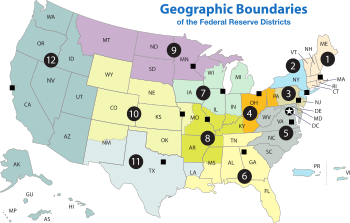The 12 Federal Reserve Banks form a major part of the Federal Reserve System, the central banking system of the United States. The 12 federal reserve banks together divide the nation into 12 Federal Reserve Districts, the 12 banking districts created by the Federal Reserve Act of 1913. The twelve Federal Reserve Banks are jointly responsible for implementing the monetary policy set by the Federal Open Market Committee (FOMC). Each federal reserve bank is also responsible for the regulation of the commercial banks within its own particular district.

The Federal Reserve officially identifies Districts by number and Reserve Bank city.
- 1st District (A) – Federal Reserve Bank of Boston
- 2nd District (B) – Federal Reserve Bank of New York
- 3rd District (C) – Federal Reserve Bank of Philadelphia
- 4th District (D) – Federal Reserve Bank of Cleveland, with branches in Cincinnati, Ohio and Pittsburgh, Pennsylvania
- 5th District (E) – Federal Reserve Bank of Richmond, with branches in Baltimore, Maryland and Charlotte, North Carolina
- 6th District (F) – Federal Reserve Bank of Atlanta, with branches in Birmingham, Alabama; Jacksonville, Florida; Miami, Florida; Nashville, Tennessee; and New Orleans, Louisiana
- 7th District (G) – Federal Reserve Bank of Chicago, with a branch in Detroit, Michigan
- 8th District (H) – Federal Reserve Bank of St. Louis, with branches in Little Rock, Arkansas; Louisville, Kentucky; and Memphis, Tennessee
- 9th District (I) – Federal Reserve Bank of Minneapolis, with a branch in Helena, Montana
- 10th District (J) – Federal Reserve Bank of Kansas City, with branches in Denver, Colorado; Oklahoma City, Oklahoma; and Omaha, Nebraska
- 11th District (K) – Federal Reserve Bank of Dallas, with branches in El Paso, Texas; Houston, Texas; and San Antonio, Texas
- 12th District (L) – Federal Reserve Bank of San Francisco, with branches in Los Angeles, California; Portland, Oregon; Salt Lake City, Utah; and Seattle, Washington
The New York Federal Reserve district is the largest by asset value. San Francisco, followed by Kansas City and Minneapolis, represent the largest geographical districts. Missouri is the only state to have two Federal Reserve Banks (Kansas City and St. Louis). California, Florida, Missouri, Ohio, Pennsylvania, Tennessee, and Texas are the only states which have two or more Federal Reserve Bank branches seated within their states, with Missouri, Pennsylvania, and Tennessee having branches of two different districts within the same state. In the 12th District, the Seattle Branch serves Alaska, and the San Francisco Bank serves Hawaii. New York, Richmond, and San Francisco are the only banks that oversee non-U.S. state territories. The System serves these territories as follows: the New York Bank serves the Commonwealth of Puerto Rico and the U.S. Virgin Islands; the Richmond Bank serves the District of Columbia; the San Francisco Bank serves American Samoa, Guam, and the Commonwealth of the Northern Mariana Islands. The Board of Governors last revised the branch boundaries of the System in February 1996.
Current Federal Reserve Presidents
| Boston | Eric S Rosengren |
| New York | William C Dudley |
| Philadelphia | Charles Plosner |
| Cleveland | Sandra Pianalto |
| Richmond | Jeffrey M Lacker |
| Atlanta | Dennis P Lockahrt |
| Chicago | Charles L Evans |
| St Louis | James B Bullard |
| Minneapolis | Narayam Kocherlakola |
| Kansas City | Esther George |
| Dallas | Richard W Fisher |
| San Francisco | John C Williams |

 Saving...
Saving...